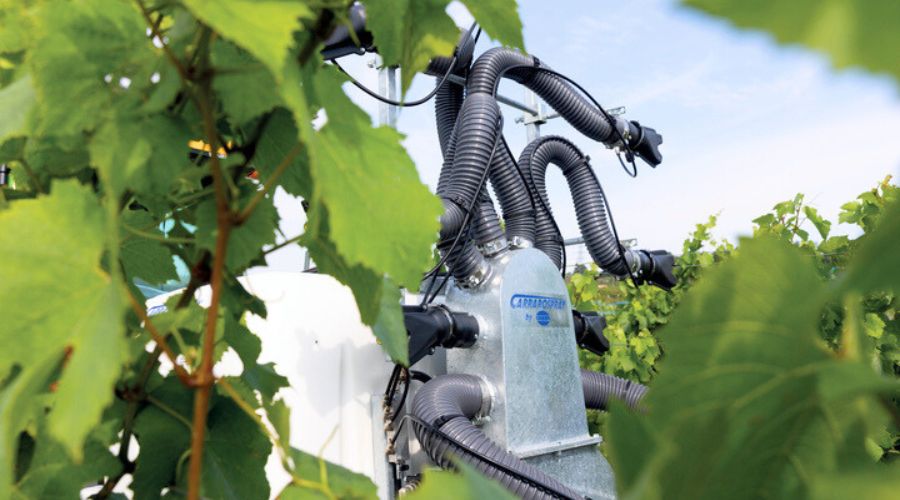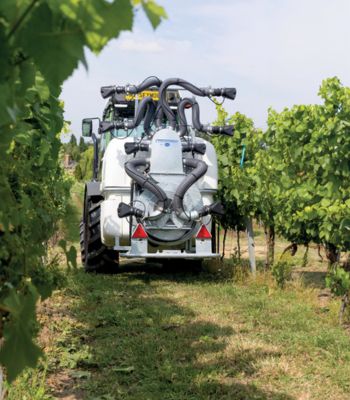Improving sprayer efficiency
14th July 2024
In mid-April, as part of WineGB’s Conference for Growth, there was a practical demonstration of best practice sprayer usage and calibration, undertaken by the NP Seymour team.

The demonstration was conducted by NP Seymour sales specialist, Tim Sillence.
During the demonstration, Tim explained that before calibrating your sprayer or undertaking any spraying, you should already have in mind a desired application rate.
He pointed out that all sprayer operators should have completed a PA3 course, and therefore would be aware of how to correctly work out the desired rate based around litres per minute per nozzle and so on; but a handy checklist written by Hutchinsons agronomist, Rob Saunders was presented to attendees earlier in the day as a reminder.
For the demo, the spray was calibrated based on a 5kph speed, with a 2.2 row width, and a target rate of 400-litres/ha.
“Once you’ve worked your sum out and have your desired litres per minute, you will be able to put this into a flow rate chart which will point you in the direction of which nozzle to use,” explained Tim.
For this particular calibration, the application came out at 0.92-litres/min per nozzle, which pointed to a yellow nozzle on the chart. Tim uses an Albuz ATR, which he explained have a really high parameter to work at different pressure levels, and are one of the most popular nozzles on the market.
Tim continued: “Once your figures are confirmed, it’s time to check the sprayer. It’s really important when you do your test that you do it exactly the same as you would if you were actually operating it, so don’t let the PTO just tick over – it needs to be running at the speed and pressure that you would actually be operating at.
“Every time you change your application rate and recalibrate, you should be re-checking the sprayer.”
Calibration checklist
The sprayer calibration checklist provided by Hutchinsons agronomist Rob Saunders offers a useful summary of the key sprayer set-up and calibration points:
- Decide your target spray volume Read the label, consider the canopy size, consider the target pest or disease, and be aware of the characteristics of the products to be applied
- Calculate forward speed Mark out 100 metres (over terrain similar to that being sprayed). Measure the time taken to cover the 100m, recording the result in seconds. Forward speed (kph) = 360 / time per 100m (seconds)
- Measure sprayed width: This is the width of the area treated in one pass of the sprayer, for example when spraying a vineyard, passing down every alleyway, the sprayed width would be the distance between the centre of one row to the centre of the next. For herbicide application, this would be the width of the herbicide strip
- Calculate sprayer output Sprayer output (litres per min) = Volume (litres per ha) x speed (kph) x sprayed width (m) / 600
- Calculate nozzle output Nozzle output = sprayer output/number of nozzles (litres per min)
- Select nozzles Consult the nozzle manufacturer’s handbook to select the appropriate nozzles to achieve the required output, operating within their rated pressure range
- Check actual output Nozzles wear and pressure gauges can be inaccurate, so measure actual output using flow meter or jug and stopwatch. Repeat for each nozzle, and replace any nozzles whose output varies by +/-10%. Alternatively, as a quick (less accurate) check, record the amount of water gone from the tank over a timed period
- Adjust pressure Repeat step 7, adjusting pressure (within the rated pressure range for the nozzles) until the target output is achieved
- Record all settings, and file for future reference.
Reliable sprayer

The demonstration featured an OCLL NPA directional sprayer, provided by NP Seymour. According to director Claire Seymour, if you’re looking for a reliable sprayer that will provide effective and efficient coverage, the range of OCLL sprayers from Carrarospray, including the NPA directional sprayer, remain the most economically priced sprayers for growers with smaller-sized orchards or vineyards.
She comments: “We have stocked Carrarospray since the mid-1980s and have always noted how these well-built sprayers have consistently proven to give many years of reliable service.”
The rear-mounted sprayer is available with 400, 500, or 600-litre tank capacities.
The NPA air-assisted nozzle system ensures even distribution and penetration of the spray through crops. By effectively producing micrometric-sized droplets in a mist, which completely and uniformly cover the leaves with a very fine protective film, a more concentrated, even and effective application of protection products can be achieved.
Claire also points out that all sprayers should be put through a National Sprayer Testing Scheme (NSTS) test as the regulations have been changed to require an annual test for air-assisted sprayers. Weed sprayers are still on a three-year test cycle.
This is a mandatory requirement for anyone operating a sprayer and involves a thorough inspection to ensure that the equipment is operating correctly and within legal guidelines.
NP Seymour is an approved test centre and can carry out these tests at its workshop in Kent or directly on the vineyard or farm.
Read more machinery news.
